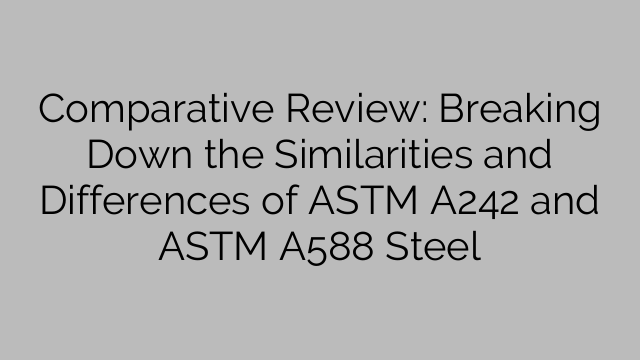Comparative Review: Breaking Down the Similarities and Differences of ASTM A242 and ASTM A588 Steel
When it comes to choosing the right steel for a construction project, it is essential to consider various factors such as strength, durability, and resistance to corrosion. Two popular weathering steels that often come up in this discussion are ASTM A242 and ASTM A588. Both steels are commonly used in applications where atmospheric corrosion resistance is required, such as bridges, buildings, and outdoor sculptures. In this article, we will dive into the similarities and differences between these two steel grades, helping you make an informed decision for your next project.
Strength:
Both ASTM A242 and ASTM A588 steels are high-strength low-alloy structural steels. However, ASTM A242 has a minimum yield strength of 50,000 psi, while ASTM A588 has a minimum yield strength of 50,000-70,000 psi. This difference in yield strength might be crucial depending on the specific requirements of your project.
Устойчивост на корозия:
One of the key similarities between ASTM A242 and ASTM A588 is their excellent resistance to atmospheric corrosion. Weathering steels develop a protective layer of rust when exposed to the elements, which acts as a barrier against further corrosion. This natural patina not only enhances the appearance of the steel but also provides long-term protection. Both steels can resist the corrosive effects of rain, snow, humidity, and other environmental factors.
Химичен състав:
While both steels share some common elements, their chemical compositions are slightly different. ASTM A242 contains copper, chromium, nickel, and phosphorus. Copper acts as a corrosion resistance enhancer, while chromium improves oxidation resistance. The inclusion of nickel increases the steel’s toughness, while phosphorus enhances its strength. On the other hand, ASTM A588 contains copper, chromium, nickel, and vanadium. The addition of vanadium enhances the steel’s strength and makes it suitable for high-stress applications.
Weldability:
When it comes to weldability, ASTM A242 and ASTM A588 have similar characteristics. Both steels can be welded using common welding methods such as arc welding, resistance welding, and gas welding. However, it is important to follow proper welding procedures to prevent any detrimental effects on the steel’s corrosion resistance.
Availability and Cost:
ASTM A242 and ASTM A588 steels are widely available in the market. Their availability makes it easier to source them for your construction project. In terms of cost, while these steels may be slightly more expensive than traditional carbon steels, their long-term durability and resistance to corrosion justify the investment.
Заключение:
When comparing ASTM A242 and ASTM A588 steels, it’s essential to consider your project’s specific requirements. Both steels offer excellent corrosion resistance and high-strength properties, making them suitable for outdoor applications. ASTM A588 provides a slightly higher yield strength and contains vanadium for increased strength. ASTM A242, on the other hand, contains phosphorus for enhanced strength. Whether you choose one over the other will depend on the particular needs of your project. Consult with a steel supplier or engineering professional to ensure you select the most appropriate steel for your application.
Overall, both ASTM A242 and ASTM A588 steels are reliable choices for weathering steel applications. Their unique properties and corrosion resistance make them popular in construction projects exposed to the elements. By understanding the similarities and differences between these steel grades, you can make an informed decision that meets the requirements of your specific project.

